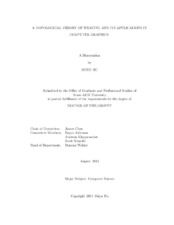| dc.description.abstract | Recent advances in the computer graphics of woven images on surfaces in 3-space motivate the development of weavings for arbitrary genus surfaces. We present herein a general framework for weaving structures on general surfaces in 3-space, and through it, we demonstrate how weavings on such surfaces are inducible from connected graph imbeddings on the same surfaces. The necessary and sufficient conditions to identify the inducible weavings in our framework are also given. For low genus surfaces, like plane and torus, we extend our framework to the weavings which are inducible from disconnected imbedded graphs. In particular, we show all weavings on a plane are inducible in our framework, including most Celtic Knots.
Moreover, we study different weaving structures on general surfaces in 3-space based on our framework. We show that any weaving inducible in our framework can be converted into an alternating weaving by appropriately changing the strand orders at some crossings. By applying a topological surgery operation, called doubling operation, we can refine a weaving or convert certain non-twillable weavings into twillable weavings on the same surfaces. Interestingly, two important subdivision algorithms on graphs imbeddings, the Catmull-Clark and Doo-Sabin algorithms, correspond nicely to our doubling operation on induced weavings. Another technique we used in studying weaving structures is repetitive patterns. A weaving that can be converted into a twillable weaving by our doubling operation has a highly-symmetric structure, which consists of only two repetitive patterns. An extension of the symmetric structure leads to Quad-Pattern Coverable meshes, which can be seamlessly covered with only one periodic pattern. Both of these two topological structures can be represented with simple Permutation Voltage graphs.
A considerable advantage of our model is that it is topological. This permits the graphic designer to superimpose strand colors and geometric attributes — distances, angles, and curvatures — that conform to manufacturing or artistic criteria.
We also give a software example for plane weaving construction. A benefit of the software is that it supports plane weaving reconstructions from an image of a plane weaving, which could be useful for recording and modifying existing weavings in real life. | en |


